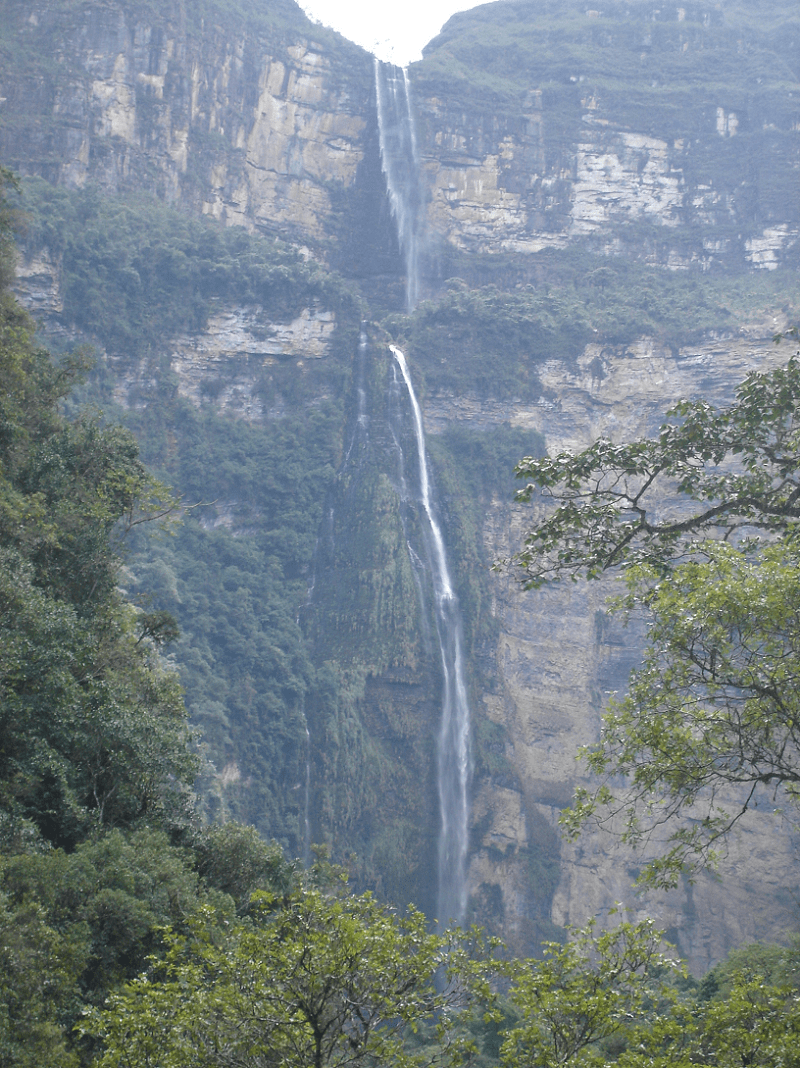Gocta Cataracts Facts
- The term Gocta Cataracts serves as the english language name for this visually stunning masterpeice of geological forces. It has other titles in different languages, though. In Spanish, for example, it holds the similar moniker of Catarata del Gocta.
- But, among the local inhabitants of the region, it’s often referred to as La Chorrera. No matter which term one chooses to use when referring to it, however, this remarkable waterfall remains a true marvel. The beautiful site also holds a surprising fact.
- The Indigenous peoples of the region clearly knew of its existence for untold centuries. In fact, it sits in full view of a nearby village. They intentionally hid its existence from outsiders due to a common fear of the effects of a curse if it became widely known.
- Due to the prevalence of this belief, the outside world did not learn of the existence of the Gocta Cataracts until 2002! At that time, the German explorer, Stefan Ziemendorff, and an accompanying team of Peruvian explorers discovered the formation.
- Because of its amazing beauty, the government of the country in which the cascade sits quickly designated it as a tourist destination. Despite this worrisome fact, officials put measures in place intended to protect the site as much as possible.
Related Articles
Gocta Cataracts Physical Description
The breathtaking Gocta Cataracts distinguishes itself from related features around the world. The wonder does so, however, due to several factors. Its eye-catching beauty certainly ranks as one, of course. Yet it also boasts some extraordinary physical statistics.
The gorgeous cascade easily serves as a truly remarkable example of high altitude geology. It also developed with a total of two separate drops, or tiers. Combined, these provide with flow of water with a total drop measuring an incredible 2,530 ft (771 m)!
The upper section of the waterfall itself drops an already impressive 700 ft (213 m). But that’s only the beginning of its amazing size. It’s the lower of the two falls that adds the greatest portion. This second tier plummets an almost unbelievable 1,831 ft (558 m)!
Magnificent Gocta Cataracts contains still more marvels to mention. It also has a very respectable width, as well. At its widest point as it plunges over the underlying bed, this extreme example of the works of Nature has a width equaling roughly 200 ft (61 m) across.
Last, but certainly not least, is the fact of just how high it sits. The upper section lies at an altitude of approximately 7,500 ft (2,286 m) above sea level. Due to this extreme height, at times the top of the geological construction is actually obscured by clouds.
Gocta Cataracts Location, Formation, and Ecology
The mind-numbing beauty best known as the Gocta Cataracts formed in a region of the globe already famous for its abundance of natural splendor. As a result, that location won’t surprise many people. It formed in what’s now known as the continent of South America.
Within the confines of that greater area, the site sits in the general western portion of the continent. Its location places it in the country of Peru. The waterfall exists in the province of Bongara, and appears roughly 479 mi (771 km) northeast of the city of Lima.
Given its geographical location, it understandably owes its existence to a combination of factors. It receives the majority of its water from outflow from the relatively nearby Andes Mountains. Despite their proximity to the equator, many glaciers exist due to the altitude.
Runoff from these serves as the principal source of water for this cascade. Yet the nature of the climate in the surrounding area also assists. The region has an extremely humid climate, and torrential rains frequently occur. All these contribute to maintaining its flow.
The area immediately surrounding the Gocta Cataracts qualifies as what’s known as a cloud forest. That creates a very unique ecosystem, in which this formation plays an important role. The water it provides helps to maintain a rich, thriving local environment.
A wide array of flora remains abundant due to the high levels of moisture present. That includes the lush jungle vegetation typical of such areas. At east 110 species of birds call the area home, in addition to many types of monkeys, and even an elusive species of bear.
Features Sharing Its Region
Check out our other articles on 7 Breathtaking Beaches of the World, Indian Red Scorpion, Blood Falls, Green Milkweed Grasshopper, Anegada ground iguana, Nicobar Pigeon

